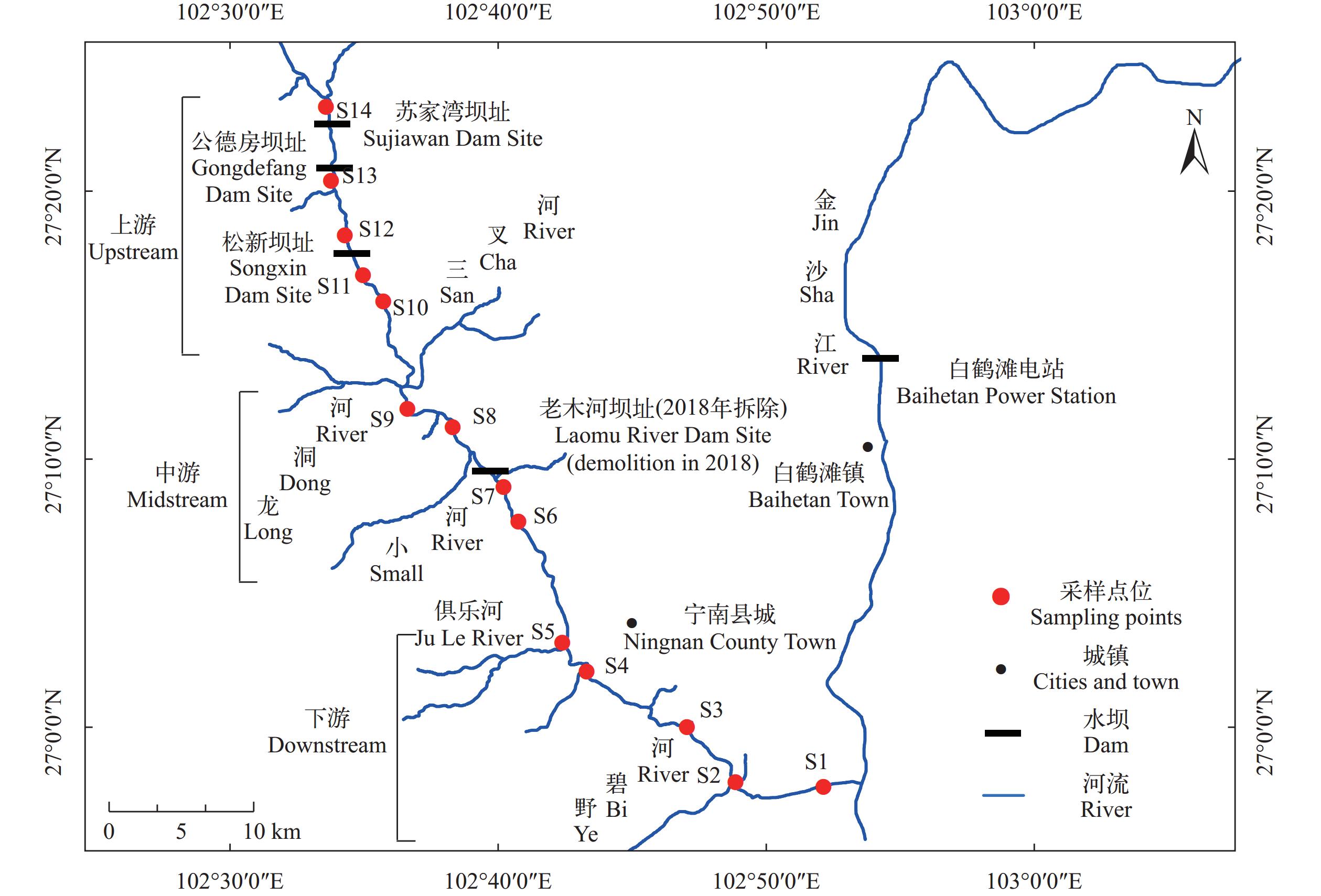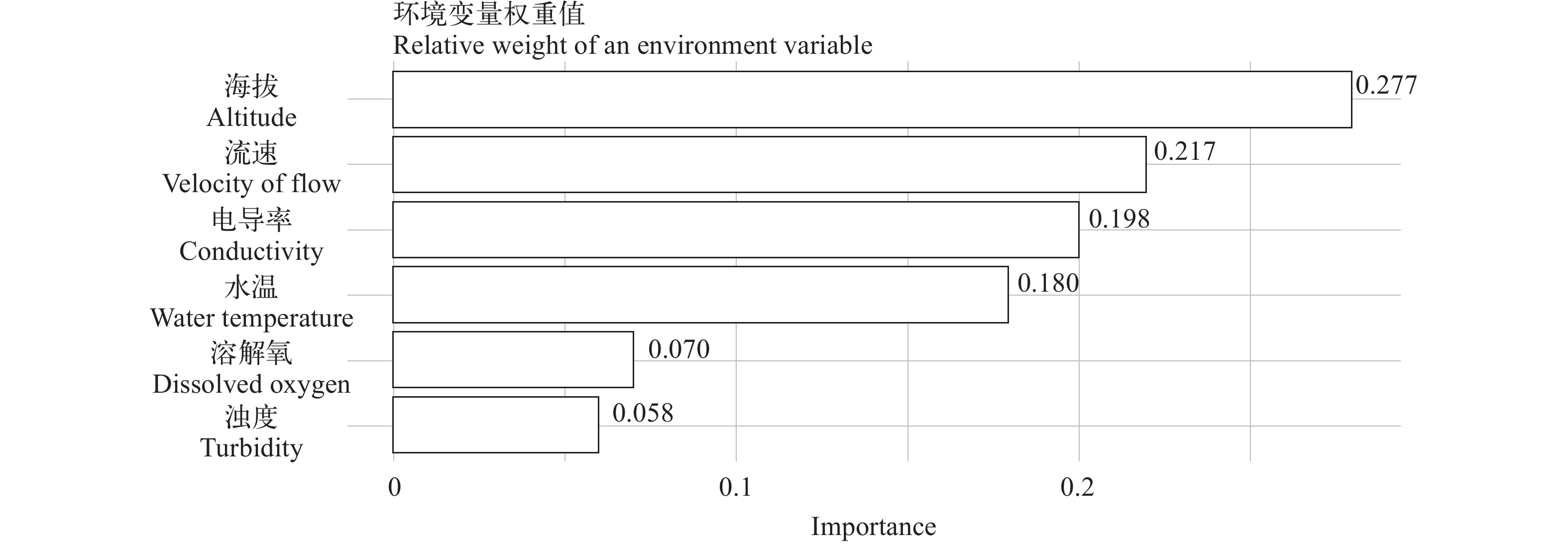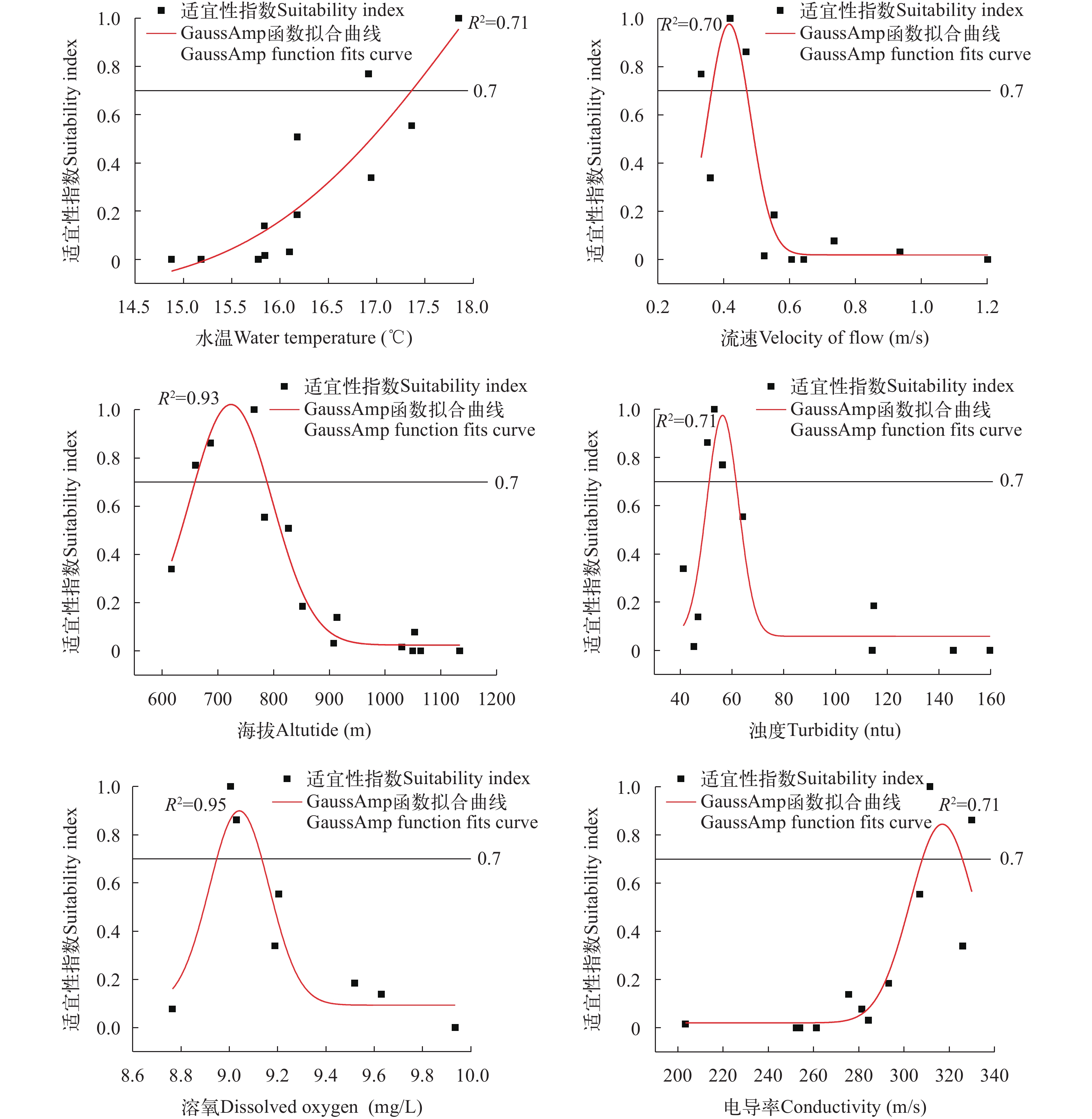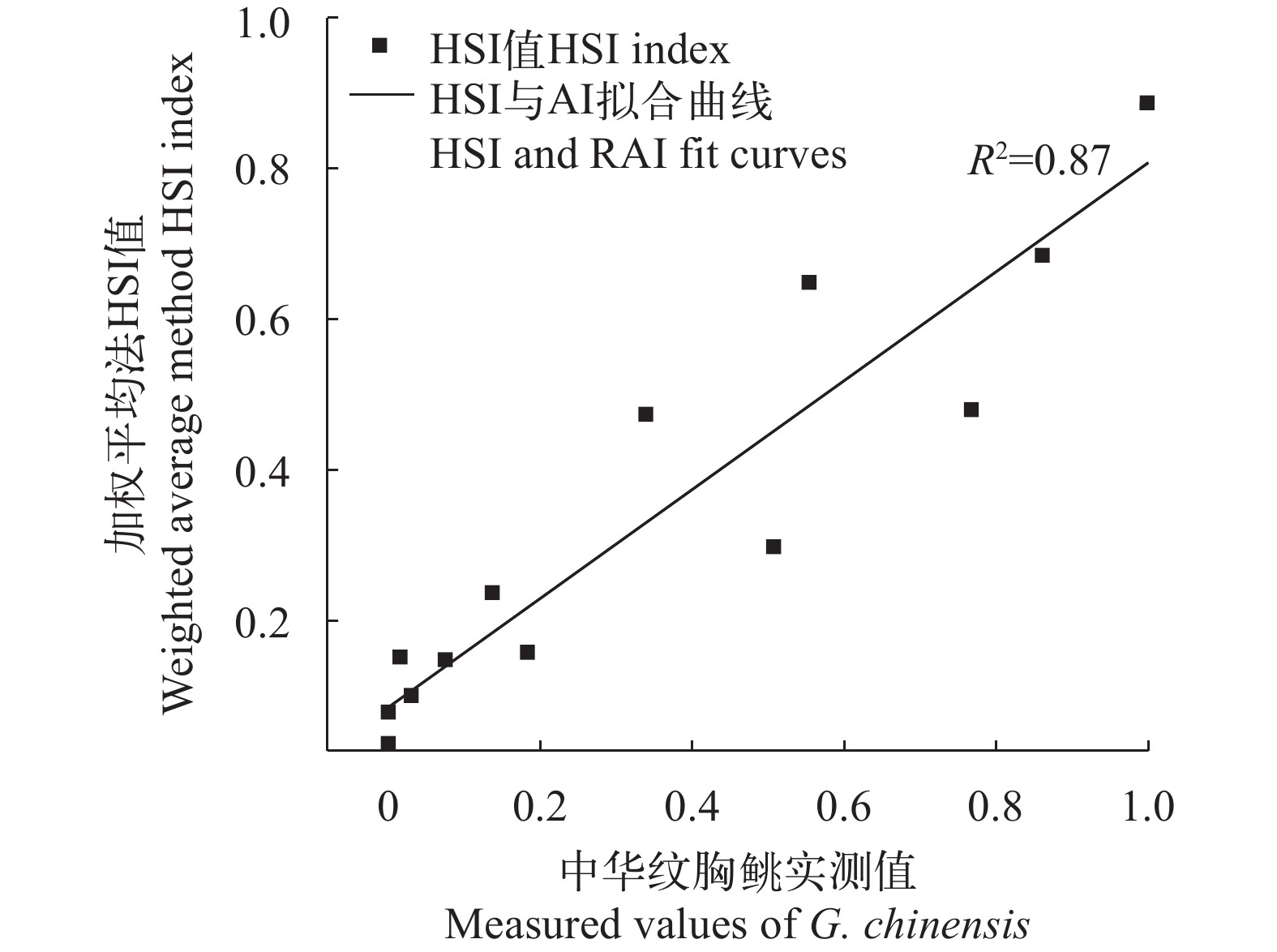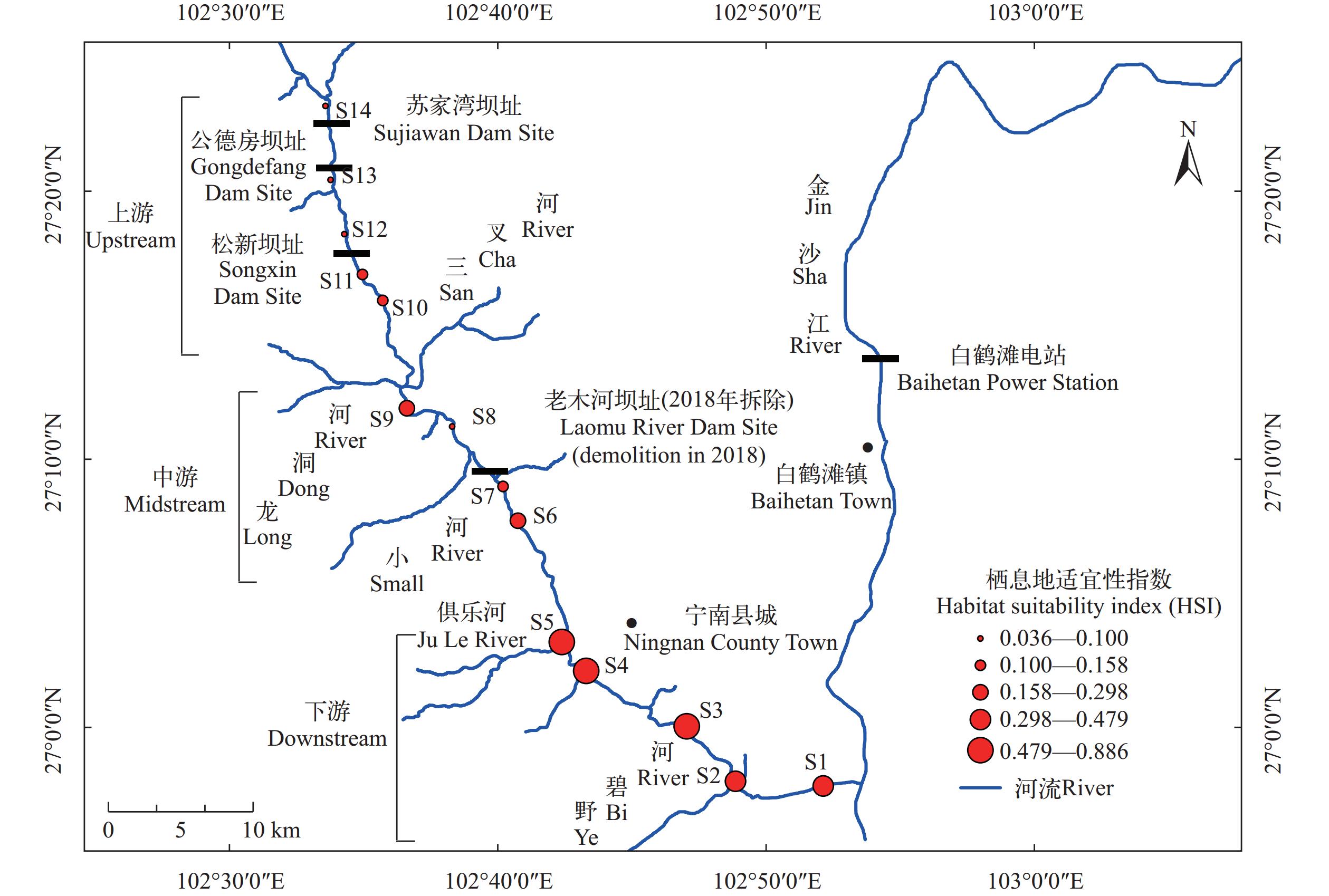ALGORITHM SCREENING AND EVALUATION OF HABITAT SUITABILITY INDEX FOR GLYPTOTHORAX SINENSE IN THE HEISHUI RIVER
-
摘要:
为研究中华纹胸鮡(Glyptothorax sinensis)栖息地适宜性指数(Habitat suitability index, HSI)模型最优算法, 科学评估其适宜栖息地分布, 基于2018—2019年黑水河中华纹胸鮡渔获物数据及同步采集的13个环境因子, 采用一元非线性函数拟合构建单个环境因子SI曲线, 并结合最大值法(Maximum, MAX)、最小值法(Minimum, MIN)、算术平均法(Arithmetic mean model, AMM)、几何平均法(Geometric mean model, GMM)、加权平均法(Weighted moving average, WMA)分别计算中华纹胸鮡HSI值。计算结果表明: 在各模型算法中, 算术平均法和加权平均法两种方法的预测结果误差最小, 最大值法与最小值法的预测结果与中华纹胸鮡实际分布偏差较大, 在进行算法选择时要慎重考虑。黑水河中华纹胸鮡栖息地适宜性指数总体呈现上游至下游纵向上升趋势, HSI值大于0.7的点位为下游自然河段S3和S4。水温、海拔等物理环境是驱动中华纹胸鮡栖息地空间分布差异的主要因素。算术平均法及加权平均法为黑水河中华纹胸鮡栖息地适宜性指数模型预测最优算法。研究结果可为黑水河鱼类栖息地评估提供参考资料, 促进鱼类栖息地保护。
Abstract:Habitat assessment is a prerequisite for in-situ conservation of fish, and appropriate model algorithms is an important basis for improving the prediction accuracy of habitat assessment models. This study aims to identify the optimal algorithm for the habitat suitability index (HSI) model of Glyptothorax sinensis and to scientifically evaluate its suitable habitat distribution. We utilized fishery catch data and 13 environmental factors collected synchronously from the Heishui River from 2018 to 2019. A one-dimensional nonlinear function was employed to fit a single environmental factor curve, and HSI values of G. sinensis were calculated using the maximum value method, minimum value method, arithmetic mean model, geometric mean model, and weighted moving average. The results indicate that among the various model algorithms, the arithmetic mean model and weighted moving average model exhibited the smallest prediction error, while the maximum and minimum value method showed significant prediction error and deviated notably from the actual distribution of G. sinensis. Therefore, caution should be taken when choosing model algorithms. Overall, the HSI index of G. sinensis in the Heishui River shows an upward trend from the upstream to the downstream, with sections S3 and S4 exhibiting HSI values greater than 0.7. Water temperature and elevation are the main driving factors for the spatial distribution differences in G. sinensis habitat. The arithmetic mean model and weighted moving average model are identified as the optimal algorithm for predicting the habitat suitability index of G. sinensis in the Heishui River. The research results can provide reference for the assessment of fish habitats in the Heishui River and promote the protection of fish habitats.
-
Keywords:
- Habitat suitability index /
- Optimal algorithm /
- Heishui River /
- Glyptothorax sinensis
-
中华鳖(Pelodiscus sinensis)是我国常见的水产养殖品种, 年产量达30余万吨[1]。一直以来, 水产养殖业选取效益较高的性别进行单性养殖, 是很多学者研究的目标, 中华鳖养殖业也具有高效全雄繁育的需求。近些年, 虽然国内外学者围绕中华鳖的性别控制及单性繁育已开展了一系列的探索性研究, 但仍未取得实质性进展[2]。开展中华鳖性控育种, 首先需要了解其性别差异的理论机制, 特别是在分子生物学层面上, 为此我们做了一些研究尝试。在之前的工作中, 我们通过对中华鳖发育初期雌雄性腺转录组进行差异分析, 筛选到许多与性别相关的基因, 组蛋白H2A变体就是其中之一, 其相对表达量与中华鳖雌性性别显著相关(数据未发表)。因此, 我们以组蛋白H2A变体为目标基因, 对其进行初步研究。
组蛋白H2A是染色质核小体的核心组蛋白之一(H3、H4、H2A和H2B), 是维持染色体结构和功能所必需的[3, 4], 组蛋白H2A广泛参与了转录调控、DNA修复和染色质浓缩等生物学过程[5—7]。此外, 组蛋白H2A还拥有众多变体, 其中包括H2A.X、H2A.Z、H2A.BbD和macroH2A等[8—10]。它们的差异主要在于C端的长度和序列的不同[11]。MacroH2A和H2A-Bbd仅限于脊椎动物或哺乳动物[12], MacroH2A主要富集在哺乳动物雌性中的非活性X染色体上[13], H2A Bbd则定位于活性X染色体和常染色体[12], 而H2A.X和H2A.Z则在整个基因组中组成性表达和定位[14]。在小鼠(Mus musculus)中, H2A.Z几乎不存在于正在生长的卵母细胞核中(第5天卵母细胞除外), 但是在囊胚期的细胞核中可以检测到荧光信号[11]。在裂殖酵母(Schizosaccharomyces pombe)中, H2A.Z还可以通过调节染色体结构, 以促进减数分裂中DNA双链断裂(DSB)的形成, 从而促进配子的发生[15]。H2A.X在小鼠整个卵子发生过程中和植入前的胚胎的核中都可检测到其表达[11], 同时敲除H2A.X可以导致雄性小鼠不育[16]。H2A.Bbd在小鼠胚胎原核期和2细胞期的细胞核中均显示较弱的表达信号, 但从4细胞期到胚泡期的细胞核中可以检测到强信号[11]。同时, 也有研究表明H2A.Bbd也存在于哺乳动物睾丸的高级生精组分和人类成熟精子的染色质中[17]。然而, 目前在龟鳖类动物中有关组蛋白H2A变体在性别分化中的功能尚未得到很好的解析。在这里, 我们克隆了中华鳖PsH2A的同源物, 分析其表达模式, 并对其转录本在卵巢组织中进行卵母细胞定位, 以研究其在卵母细胞发育成熟过程中的作用。
1. 材料与方法
1.1 实验动物的收集和处理
实验于2019年1、4、7和10月份选取1、2和3冬龄健康的中华鳖, 雌雄各6只, 共144只, 全部来自于广东惠州财兴实业有限公司。将鳖麻醉后放血, 解剖, 掀开背甲, 然后采集精巢、卵巢、心脏、肝脏、脾脏、肾脏、脑和肌肉等组织, 速冻后, −80℃保存, 用于总RNA提取。另外, 再取一部分卵巢组织用4%多聚甲醛(Solarbio, China)固定, 4℃冰箱过夜。然后用甲醇/1×PBS(DEPC水配制)梯度脱水, 并置于100%甲醇中, −20℃保存, 用于制备切片。
1.2 RNA的提取与cDNA的合成
采集的组织使用Eastep® Super试剂盒(Promega, China)提取总RNA, 浓度和纯度由NanoQTM分光光度计测定, RNA的完整性由1%琼脂糖凝胶电泳检测, 使用M-MLV反转录试剂盒(Invitrogen, USA)进行cDNA第一链的合成。
1.3 中华鳖PsH2A cDNA的克隆
根据测序所得的中华鳖PsH2A cDNA序列, 设计上下游特异性引物Ps-H2A-F和Ps-H2A-R (表 1)。以中华鳖卵巢cDNA为模板进行PCR扩增, 反应条件为: 94℃ 2min; 98℃ 30s, 55℃ 30s, 72℃ 90s (共35个循环); 72℃延伸10min。PCR产物使用Gel Extraction Kit (Omega, China)试剂盒回收。然后将目的片段连接到pMD19-T (TaKaRa, China)载体, 转化至DH5α感受态细胞(TaKaRa, China)中, 克隆筛选, 并将阳性克隆送广州天一辉远基因科技有限公司测序。DNAMAN软件预测氨基酸序列, Clustal W (BioEdit)软件进行氨基酸序列对比, 按MEGA 7软件的邻近法(Neighbour-Joining, NJ)构建系统进化树。
表 1 用于中华鳖PsH2A基因克隆和表达分析的引物Table 1. Primers used for cDNA cloning and expression analysis of PsH2A in P. sinensis名称Name 序列Sequences (5′—3′) 用途Purpose Ps-H2A-F AATGCGTTGACTCAAACAAT For the isolation of cDNA Ps-H2A-R TACCCTTTAGCAGCAATACAC PsDL-H2A-F AAAGTGCCCCTTCTTCAGGT RT-qPCR/RT-PCR PsDL-H2A-R TAGGCTGTTGGGAGGAAATG EF1αF ACTCGTCCAACTGACAAGCCTC Normalization for RT-qPCR/RT-PCR EF1αR CACGGCGAACATCTTTCACAG PsCISH-H2A-F AGGCTGTTGGGAGGAAATG For the amplification of probe PsCISH-H2A-R TTGCGGAATAGTCACATGGTTG 1.4 组织表达
根据测序所得的中华鳖PsH2A cDNA序列, 设计一对特异的定量引物PsDL-H2A-F和PsDL-H2A-R, 并以中华鳖EF1α为内参基因(表 1)。以成体卵巢、精巢、心脏、肝脏、脾脏、肾脏、脑和肌肉的cDNA为模板, 进行RT-qPCR和RT-PCR扩增。RT-qPCR扩增反应在StepOnePlus real-time PCR System (Applied Biosystems)中完成, 每组3个平行重复, 采用2–∆∆Ct法来计算目的基因的相对表达量, 反应程序如下: 95℃预变性10min; 95℃ 15s, 60℃ 15s, 72℃ 15s (共40个循环); 95℃ 15s, 60℃ 30s, 95℃ 15s。RT-PCR使用与RT-qPCR相同的特异性引物(PsDL-H2A-F/PsDL-H2A-R, 表 1)进行扩增, 反应程序如下: 94℃ 2min; 98℃ 30s, 58℃ 30s, 72℃ 40s (共30个循环); 72℃延伸10min。作为对照, 从相同的cDNA样本中扩增出内参基因(EF1α)。RT-PCR产物由1%的琼脂糖凝胶进行分离, 并拍照(Alpha Innotech, USA)。
1.5 探针的制备
根据测序所得的中华鳖PsH2A cDNA序列设计一对特异性引物PsCISH-H2A-F和PsCISH-H2A-R(表 1), PCR扩增产物通过1%的琼脂糖凝胶分离, 并用Gel Extraction Kit试剂盒(Omega, China)进行胶回收。将纯化后的产物连接到pMD19-T(TaKaRa, China)载体中, 然后转入DH5α感受态细胞(TaKaRa, China)中, 筛选阳性克隆, 提取质粒, 送至天一辉远生物技术有限公司进行测序。使用SP6/T7 Enzyme Mix (Roche, Germany)和Digoxigenin (DIG) RNA Labeling试剂盒(Roche, Germany)体外合成正反义探针。
1.6 冰冻切片的制备
将现取的卵巢组织, 置于4%的多聚甲醛(Solarbio, China)中, 4℃冰箱固定过夜。使用甲醇/1×PBS(DEPC水配制)梯度脱水, −20℃保存。待切片时, 使用甲醇/1×PBS(DEPC水配制)梯度复水, 并置于30%蔗糖溶液中, 4℃冰箱过夜, 具体步骤按张飘逸等人的方法进行[18]。待组织块完全沉入管底后, 取出, 用OCT(SAKURA, USA)包埋, Leica冷冻切片机(CM1950)切成4—6 μm厚的切片贴于防脱载玻片上。
1.7 化学原位杂交
化学原位杂交操作过程按照Xu等[19, 20]的方法进行。采用BCIP/NBT(Roche, Germany)显色液进行化学显色, 50%甘油(PBS配置)封片, 使用尼康Ri2显微镜观察并用NIS Elements成像系统拍照。根据中华鳖卵子发生过程中滤泡细胞及透明带等结构特征, 对其进行分期和鉴定[21, 22]。
1.8 数据分析
每个实验独立重复至少3次。所有实验数据均以平均值±标准误表示, 并使用SPSS软件进行方差分析和Duncan氏多重比较, P<0.05表示差异显著。
2. 结果
2.1 中华鳖PsH2A cDNA序列特征
克隆获得的中华鳖PsH2A cDNA (GenBank登录号: MZ546415)序列全长为575 bp, 5′端非编码区(5′-UTR) 68 bp, 3′端非编码区(3′-UTR) 108 bp, 开放阅读框(Open reading frame, ORF)为399 bp, 共编码133个氨基酸, 具有H2A超家族特有的结构功能域, 我们将其命名为PsH2A。氨基酸序列同源性比对结果显示: 其与三趾箱龟(Terrapene carolina triunguis)和绿海龟(Chelonia mydas)的同源性最高, 分别为82.71%和80.45%; 与白喉带鹀(Zonotrichia albicollis)和朱红蜂鸟(Calypte anna)的同源性分别为56.92%和51.11%; 与非洲爪蛙(Xenopus tropicalis)和蚓螈(Microcaecilia unicolor)的同源性分别为52.38%和49.59%; 与斑马鱼(Danio rerio)和虹鳟(Oncorhynchus mykiss)的同源性分别为53.49%和54.26%; 与人(Homo sapiens)和褐家鼠(Rattus norvegicus)的同源性分别为52.71%和54.55%。NJ系统进化树结果表明, PsH2A在进化关系上与龟类动物较近, 其次是鸟类、两栖类和鱼类, 与哺乳动物较远(图 1)。
![]() 图 1 采用NJ法构建中华鳖PsH2A系统进化树所有数据均来自NCBI数据库, 所列如下: 三趾箱龟(Terrapene carolina triunguis), XP_024072074.1; 绿海龟(Chelonia mydas), XP_007060964.1; 白喉带鹀(Zonotrichia albicollis), XP_005486490.1; 朱红蜂鸟(Calypte anna), XP_008496341.1; 非洲爪蛙(Xenopus tropicalis), XP_018098350.1; 蚓螈(Microcaecilia unicolor), XP_030060807.1; 斑马鱼(Danio rerio), NP_001019567.2; 虹鳟(Oncorhynchus mykiss), XP_021479503.1; 人(Homo sapiens), NP_003508.1; 褐家鼠(Rattus norvegicus), AAB53641.1Figure 1. Phylogenetic tree using the neighbor-joining methodAll the amino acid sequences are retrieved from NCBI database as below: Terrapene carolina triunguis (XP_024072074.1); Chelonia mydas (XP_007060964.1); Zonotrichia albicollis (XP_005486490.1); Calypte anna (XP_008496341.1); Xenopus tropicalis (XP_018098350.1); Microcaecilia unicolor (XP_030060807.1); Danio rerio (NP_001019567.2); Oncorhynchus mykiss (XP_021479503.1); Homo sapiens (NP_003508.1); Rattus norvegicus (AAB53641.1)
图 1 采用NJ法构建中华鳖PsH2A系统进化树所有数据均来自NCBI数据库, 所列如下: 三趾箱龟(Terrapene carolina triunguis), XP_024072074.1; 绿海龟(Chelonia mydas), XP_007060964.1; 白喉带鹀(Zonotrichia albicollis), XP_005486490.1; 朱红蜂鸟(Calypte anna), XP_008496341.1; 非洲爪蛙(Xenopus tropicalis), XP_018098350.1; 蚓螈(Microcaecilia unicolor), XP_030060807.1; 斑马鱼(Danio rerio), NP_001019567.2; 虹鳟(Oncorhynchus mykiss), XP_021479503.1; 人(Homo sapiens), NP_003508.1; 褐家鼠(Rattus norvegicus), AAB53641.1Figure 1. Phylogenetic tree using the neighbor-joining methodAll the amino acid sequences are retrieved from NCBI database as below: Terrapene carolina triunguis (XP_024072074.1); Chelonia mydas (XP_007060964.1); Zonotrichia albicollis (XP_005486490.1); Calypte anna (XP_008496341.1); Xenopus tropicalis (XP_018098350.1); Microcaecilia unicolor (XP_030060807.1); Danio rerio (NP_001019567.2); Oncorhynchus mykiss (XP_021479503.1); Homo sapiens (NP_003508.1); Rattus norvegicus (AAB53641.1)2.2 中华鳖PsH2A mRNA组织表达
以EF1α为内参基因, 利用RT-qPCR和RT-PCR检测PsH2A转录本在4月份, 1冬、2冬和3冬龄中华鳖各组织中的相对表达。结果显示, 在1冬、2冬和3冬龄中华鳖个体中, PsH2A mRNA在卵巢中具有较高水平的表达(P<0.01), 而在精巢、肌肉、脑、肾脏、脾脏、肝脏和心脏等体组织中几乎检测不到, 提示中华鳖PsH2A mRNA的表达具有组织特异性和性别二态性。PsH2A mRNA在1冬龄到3冬龄中华鳖雌雄性腺的表达见图 2。PsH2A mRNA在3冬龄中华鳖体组织中的表达见图 3。
2.3 中华鳖PsH2A mRNA在卵母细胞发生过程中的表达分布
1冬龄中华鳖卵巢发育至初级卵泡期, 初级卵母细胞核位于细胞中央, 部分细胞核由于染色质空泡的出现被挤压到细胞边缘; 2冬龄中华鳖卵巢进入生长期, 卵巢内具有各个时期的卵泡, 少部分卵泡进入成熟期, 卵黄颗粒在卵的周围开始积累; 3冬龄中华鳖卵巢已经进入成熟期, 输卵管附近可见石灰质壳的卵[23, 24]。我们选取2冬龄中华鳖卵巢切片, 对PsH2A进行细胞定位, 化学原位杂交结果显示: PsH2A转录本通过反义探针显示化学信号(图 4A和4B), 而正义探针检测不到信号(图 4C和4D)。PsH2A mRNA在卵母细胞中特异性表达, 并且在初期卵母细胞发育至第Ⅲ期的时候, 表达信号最强, 且均匀地分布在卵母细胞质中。在初级卵母细胞发育至第Ⅴ期的时候, 目的信号减弱, 信号从细胞核周围至细胞质外围逐渐递减。随着发育进程, 卵母细胞逐渐增大, 进入生长期和成熟期, 目的信号逐渐减弱。在生长期(第Ⅶ期)卵母细胞中, 目的信号呈片状分布在细胞核周围区域, 信号强度较第Ⅴ期的卵母细胞更弱, 细胞质外围几乎很难检测目的信号(图 4A)。在成熟期(第Ⅸ期)卵母细胞中, 目的信号在细胞核周围呈斑点状分布, 而在细胞质外围已经检测不到目的信号(图 4B)。PsH2A的这种特殊表达模式, 提示其在中华鳖卵母细胞发育过程中的重要作用。
![]() 图 4 通过化学原位杂交分析中华鳖PsH2A mRNA在卵巢中的表达PsH2A转录本通过反义探针显示化学信号, 以碱性磷酸酶(AP)显色(A, B), 正义探针检测不到信号(C, D)。Ⅲ和Ⅴ为初级卵母细胞, Ⅶ为生长期卵母细胞, Ⅸ为成熟期卵母细胞。黑色箭头指示典型的原位杂交信号。标尺=100 µmFigure 4. The PsH2A mRNA expression in ovary by chemical in situ hybridizationA and B. The transcript of PsH2A shows chemical signal through antisense probe, stained with alkaline phosphatase (AP); C and D. No signal detected by sense probe. The black arrow indicates the chemical in situ hybridization signal. Ⅲ and Ⅴ, Primary oocytes; Ⅶ, Growing oocytes; Ⅸ, Mature oocytes. Scale bars=100 µm
图 4 通过化学原位杂交分析中华鳖PsH2A mRNA在卵巢中的表达PsH2A转录本通过反义探针显示化学信号, 以碱性磷酸酶(AP)显色(A, B), 正义探针检测不到信号(C, D)。Ⅲ和Ⅴ为初级卵母细胞, Ⅶ为生长期卵母细胞, Ⅸ为成熟期卵母细胞。黑色箭头指示典型的原位杂交信号。标尺=100 µmFigure 4. The PsH2A mRNA expression in ovary by chemical in situ hybridizationA and B. The transcript of PsH2A shows chemical signal through antisense probe, stained with alkaline phosphatase (AP); C and D. No signal detected by sense probe. The black arrow indicates the chemical in situ hybridization signal. Ⅲ and Ⅴ, Primary oocytes; Ⅶ, Growing oocytes; Ⅸ, Mature oocytes. Scale bars=100 µm2.4 中华鳖PsH2A mRNA季节表达模式
中华鳖属于季节性繁殖动物, 我国南方养殖的中华鳖一般4—8月为产卵季节, 5—7月为产卵高峰期, 11月开始冬眠, 并将交配后的精子储存在输卵管中, 供来年受精使用[25, 26]。用RT-qPCR检测中华鳖卵巢组织中PsH2A不同季节的表达水平变化, 结果显示: 1冬龄个体卵巢PsH2A转录本的相对表达量先上升后下降再上升, 10月的表达量最高; 2冬龄个体PsH2A转录本的相对表达量先上升后下降, 在4月达到峰值; 3冬龄个体PsH2A转录本的相对表达量随着月份整体呈上升趋势。此外, 在相同月份中, 随着中华鳖年龄的增长, PsH2A转录本的相对表达量整体呈现下降趋势, 即PsH2A 表达量与年龄增长呈负相关(图 5)。
3. 讨论
卵母细胞发育过程中的重要事件之一是染色质重塑, 其中就包括组蛋白的修饰和交换[27]。本研究克隆的中华鳖PsH2A cDNA序列全长为575 bp, 编码133个氨基酸, 具有H2A超家族特有的结构功能域。在进化上, 与龟类亲缘关系最近。使用RT-qPCR和RT-PCR技术, 对中华鳖PsH2A组织差异性表达情况进行分析, 发现PsH2A mRNA在卵巢组织中高表达, 而精巢和其他组织几乎不表达, 表明PsH2A的表达在中华鳖中具有性别二态性和组织特异性。这与鱼类中发现的表达模式类似, 在异育银鲫(Carassius auratus gibelio)中, h2af1o转录本仅在成体卵巢中被检测到。在蛋白水平上, 也仅在彩鲫(Carassius auratus)和斑马鱼的卵巢中检测到类似的蛋白带[28]。
为了进一步确定PsH2A在中华鳖卵巢组织中的细胞定位, 我们对其转录本在卵巢切片中进行了原位杂交实验。结果发现PsH2A mRNA在卵母细胞中特异性表达, 在初级卵母细胞中表达信号最强, 且均匀的分布在卵母细胞质中, 此时卵母细胞发育到第Ⅲ期, 卵母细胞中灯刷染色体明显[21], 卵母细胞进行第一次减数分裂并停留在双线期, 染色体加倍。随着卵母细胞发育成熟, 细胞增大, 目的信号逐渐减弱, 主要分布在核周区域, 此时卵母细胞已经进入生长期(第Ⅶ期)和成熟期(第Ⅸ期), 已观察不到灯刷染色体的存在[21], 完成第一次减数分裂。中华鳖PsH2A mRNA在卵母细胞不同发育阶段中的表达模式似乎与减数分裂中染色体的动态变化相契合。在哺乳动物中, 组蛋白H2A的翻译后修饰和组蛋白H2A变体与染色质的结合参与了卵母细胞染色质的重塑, 对雌性配子的减数分裂和发育能力是至关重要的[29]。PsH2A这种特殊表达模式提示其在中华鳖卵母细胞发育和成熟中可能发挥着重要作用。中华鳖PsH2A mRNA在卵母细胞发育过程中的表达模式与鱼类相似[28], 而与小鼠[11]和牛(Bos indicus) [30]有所不同。在异育银鲫中, H2A变体h2af1o在整个卵子发生期间特异性表达, 在卵原细胞和初级卵母细胞中, h2af1o转录本信号均匀地分布在细胞质中, 从皮质肺泡卵母细胞到成熟卵母细胞, 转录信号主要集中在细胞质外周, 呈斑点式分布, 而在体细胞中检测不到信号。在牛的卵母细胞中, H2A转录本的表达随着卵泡的增大而逐渐增加, 暗示其对于卵母细胞的发育至关重要。Osakabe等[11]认为, 组蛋白H2A与其变异体在C端上存在差异, C端的异质性决定了其功能的不同, 解释了组蛋白H2A及其变异体在不同物种的差异表达的可能原因。
不同年龄中华鳖卵巢组织中PsH2A mRNA的相对表达量, 随着年龄增长, 呈现下降趋势。此外, 同一年龄中华鳖在不同季节中, 卵巢组织中PsH2A mRNA的水平也存在显著差异。这可能与中华鳖性成熟过程中卵巢的发育程度有关。1冬龄的中华鳖没有性成熟, 卵巢组织中主要是初级卵母细胞[24], PsH2A mRNA的相对表达量整体呈上升趋势; 2冬龄中华鳖开始性成熟, 卵巢进入生长期, 卵巢内具有各个时期的卵泡, 少部分卵泡进入成熟期[23], PsH2A mRNA在4月和7月高表达, 可能与气温逐渐升高, 卵子发生比较活跃有关; 3冬龄中华鳖完全性成熟, 其卵巢已经进入成熟期, 输卵管附近可见石灰质壳的卵[23], PsH2A的转录水平随月份逐渐升高, 可能因为卵巢已进入成熟期, 卵巢一直经历着由卵原细胞到成熟卵子的周期性过程。这也与PsH2A mRNA在卵母细胞发育过程中的原位杂交结果相一致。中华鳖PsH2A mRNA主要在初级卵母细胞中表达, 随着卵母细胞发育成熟, 表达信号逐渐减弱。中华鳖PsH2A mRNA的相对表达与卵子发育的成熟程度呈负相关, 因此可以在生产实践中将其作为评估中华鳖卵巢成熟程度和高繁殖力群体的一个潜在指标。总之, 本研究提示PsH2A在卵母细胞发育成熟过程中起着重要作用, 同时也为今后研究龟鳖类动物生殖细胞发育调控机制拓展了新思路。
-
表 1 黑水河环境因子与中华纹胸鮡RAD值相关性分析
Table 1 Correlation analysis between environmental factors and G. sinensis RAD value in Heishui River
环境因子
Environmental factor相关系数
Correlation coefficient环境因子
Environmental factor相关系数
Correlation coefficient溶解氧Dissolved oxygen (mg/L) –0.46* 电导率Conductivity (s/m) 0.85** 水温Water temperature (℃) 0.88** 悬浮物Suspended solids (mg/L) 0.28 透明度Transparency (m) 0.05 化学需氧量Chemical oxygen demand (mg/L) –0.04 流速Velocity of flow (m/s) –0.76** 总磷Phosphorus (mg/L) –0.14 水深Water depth (m) –0.37 氨氮Ammonia nitrogen (mg/L) 0.08 海拔Altitude (m) –0.87** 浊度Turbidity (ntu) –0.50* 叶绿素a Chlorophyll a –0.26 注: * 表示P<0.05存在显著性相关; ** 表示P<0.01存在极显著相关; 下同Note: * indicates significant correlation with P<0.05; ** indicates extremely significant correlation with P<0.01; the same applies below 表 2 黑水河中华纹胸鮡环境因子拟合函数
Table 2 Environmental factor fitting function of G. sinensis in Heishui River
环境因子Environmental factor 适宜性指数模型Suitability index model P值P-value 水温Water temperature (℃) y=−0.14+1.86×e(−0.5*[(Tem−20.01)/2.1])^2 **P<0.01 流速Velocity of flow (m/s) y=0.02+0.96×e(−0.5*[(Vel−0.42)/0.06])^2 *P<0.05 海拔Altitude (m) y=0.02+1×e(−0.5*[(Alt−723)/73])^2 **P<0.01 浊度Turbidity (ntu) y=0.06+0.91×e(−0.5*[(Tur−56.36)/6.15])^2 *P<0.05 溶解氧Dissolved oxygen (mg/L) y=0.09+0.8×e(−0.5*[(Dis−9.04)/0.12])^2 **P<0.01 电导率Conductivity (s/m) y=0.02+0.82×e(−0.5*[(Con−316.9)/14.27])^2 **P<0.01 表 3 黑水河环境因子及SI曲线预测适宜范围
Table 3 Suitable range for predicting environmental factors and SI curve of Heishui River
环境因子
Environmental factor最小值
Min最大值
Max平均值±标准差
mean±SD预测适宜范围
Scope of suitability水温 Water temperature (℃) 14.88 17.85 16.37±0.73 17.44—17.85 流速 Flow rate (m/s) 0.33 1.20 0.55±0.27 0.36—0.47 海拔 Altitude (m) 617 1134 834.00±190.94 659—788 浊度 Turbidity (ntu) 41.20 159.74 81.71±43.80 50.57—57.21 溶氧 Dissolved oxygen (mg/L) 8.76 9.93 9.31±0.38 8.96—9.12 电导率 Conductivity (m/s) 203.33 335.50 291.24±38.44 307.85—324.96 表 4 黑水河中华纹胸鮡五种HSI模型算法预测精度
Table 4 Prediction accuracy of five HSI model algorithms for G. chinensis from Heishuihe River
算法
AlgorithmR2 AIC值
AIC value均方根误差
RMSEP值
P-valueMax 0.70 –4.31 0.18 **P<0.01 Min 0.63 –1.12 0.20 **P<0.01 AMM 0.87 –15.98 0.12 **P<0.01 GMM 0.79 –9.03 0.15 **P<0.01 WAM 0.86 –15.22 0.12 **P<0.01 -
[1] Liu H, Guo C, Qu X, et al. Fish diversity, endemism, threats, and conservation in the Jinsha river basin (Upper Yangtze River), China [J]. North American Journal of Fisheries Management, 2021, 41(4): 967-984. doi: 10.1002/nafm.10441
[2] Yan T, He J, Yang D, et al. Fish community structure and biomass particle-size spectrum in the upper reaches of the Jinsha River (China) [J]. Animals, 2022, 12(23): 3412. doi: 10.3390/ani12233412
[3] Dai L, Wang Y, Dai H, et al. Assessment of environmental flow requirements for four major Chinese carps in the lower reaches of the Jinsha River, southwest China [J]. Frontiers in Ecology and Evolution, 2022(10): 810889. doi: 10.3389/fevo.2022.810889
[4] 曹文宣. 关于对长江水生态环境状况的评估与考核(序言) [J]. 水生生物学报, 2021, 45(6): 1381.] Cao W X. Evaluation and assessment for water ecological environment of Yangtze River (Preface) [J]. Acta Hydrobiologica Sinica, 2021, 45(6): 1381. [
[5] Liao C, Ye S, Zhai D, et al. Tributaries create habitat heterogeneity and enhance fish assemblage variation in one of the largest reservoirs in the world [J]. Hydrobiologia, 2023, 850(19): 4311-4326. doi: 10.1007/s10750-023-05306-3
[6] 滕航, 田辉伍, 刘寒文, 等. 金沙江下游支流黑水河鱼类资源现状 [J]. 生态学杂志, 2021, 40(5): 1499-1511.] Teng H, Tian H W, Liu H W, et al. Fish resources status in Heishui River, a tributary of the lower reaches of Jinsha River [J]. Chinese Journal of Ecology, 2021, 40(5): 1499-1511. [
[7] Yang S, Zhang Z, Wang Y, et al. An improved 3D fish habitat assessment model based on the graph theory algorithm [J]. Ecological Indicators, 2023(148): 110022. doi: 10.1016/j.ecolind.2023.110022
[8] Kuiper S D, Coops N C, Tompalski P, et al. Characterizing stream morphological features important for fish habitat using airborne laser scanning data [J]. Remote Sensing of Environment, 2022(272): 112948. doi: 10.1016/j.rse.2022.112948
[9] Crawford B A, Maerz J C, Moore C T. Expert-informed habitat suitability analysis for at-risk species assessment and conservation planning [J]. Journal of Fish and Wildlife Management, 2020, 11(1): 130-150. doi: 10.3996/092019-JFWM-075
[10] Brownscombe J W, Midwood J D, Cooke S J. Modeling fish habitat: model tuning, fit metrics, and applications [J]. Aquatic Sciences, 2021, 83(3): 44. doi: 10.1007/s00027-021-00797-5
[11] Northrup J M, Vander Wal E, Bonar M, et al. Conceptual and methodological advances in habitat-selection modeling: guidelines for ecology and evolution [J]. Ecological Applications, 2022, 32(1): e02470. doi: 10.1002/eap.2470
[12] 张康, 张平, 夏德军, 等. 长江江豚对孤立栖息地斑块利用规律研究及潜在因子分析 [J]. 水生生物学报, 2024, 48(10): 1633-1641.] Zhang K, Zhang P, Xia D J, et al. Utilization pattern and potential factors of the Yangtze finless porpoise in an isolated habitat patch [J]. Acta Hydrobiologica Sinica, 2024, 48(10): 1633-1641. [
[13] Zhang H, Li S, Liu Y, et al. Assessment of the habitat quality of offshore area in Tongzhou Bay, China: using benthic habitat suitability and the InVEST model [J]. Water, 2022, 14(10): 1574. doi: 10.3390/w14101574
[14] Yu W, Wen J, Chen X, et al. Effects of climate variability on habitat range and distribution of chub mackerel in the East China Sea [J]. Journal of Ocean University of China, 2021, 20(6): 1483-1494. doi: 10.1007/s11802-021-4760-x
[15] Jiang R, Sun H, Li X, et al. Habitat suitability evaluation of Harpadon nehereus in nearshore of Zhejiang province, China [J]. Frontiers in Marine Science, 2022(9): 961735. doi: 10.3389/fmars.2022.961735
[16] 严鑫, 成必新, 杨绍荣. 鱼类栖息地保护与修复措施研究 [J]. 绿色科技, 2020, 22(18): 16-19.] Yan X, Cheng B X, Yang S R. Analysis of domestic status of fish habitat protection and restoration measures [J]. Journal of Green Science and Technology, 2020, 22(18): 16-19. [
[17] Chowdhury M S N, Wijsman J W M, Hossain M S, et al. A verified habitat suitability model for the intertidal rock oyster, Saccostrea cucullata [J]. PLoS One, 2019, 14(6): e0217688. doi: 10.1371/journal.pone.0217688
[18] Lee P Y, Suen J P. Comparing habitat suitability indices (HSIs) based on abundance and occurrence data [J]. North American Journal of Fisheries Management, 2013, 33(1): 89-96. doi: 10.1080/02755947.2012.743933
[19] 杨志, 龚云, 董纯, 等. 黑水河下游鱼类资源现状及其保护措施 [J]. 长江流域资源与环境, 2017, 26(6): 847-855.] Yang Z, Gong Y, Dong C, et al. Fish resource status of the lower reaches of the Heishui river and the measures for their conservation [J]. Resources and Environment in the Yangtze Basin, 2017, 26(6): 847-855. [
[20] 褚新洛, 郑葆珊, 戴定远. 中国动物志-硬骨鱼纲. 鲇形目 [M]. 北京: 科学出版社, 1999: 133.] Zhu X L, Zheng B S, Dai D Y. Fauna Sinica, Osteichthyes, Siluriformes [M]. Beijing: Science Press, 1999: 133. [
[21] 张力文, 田辉伍, 陈大庆, 等. 长江上游中华纹胸鮡遗传多样性及遗传结构研究 [J]. 淡水渔业, 2020, 50(4): 3-11.] Zhang L W, Tian H W, Chen D Q, et al. Genetic diversity and structure of Glyptothorax sinensis in upper Yangtze River [J]. Freshwater Fisheries, 2020, 50(4): 3-11. [
[22] 李洪池, 龚君华. 雅鲁藏布江土著鮡科鱼类优先保护次序的定量分析研究 [J]. 西藏科技, 2023, 45(8): 3-8.] Li H C, Gong J H. Quantitative analysis of priority protection order of indigenous fishes in Yarlung Zangbo River [J]. Xizang Science and Technology, 2023, 45(8): 3-8. [
[23] 周伟, 李明会. 鮡科鱼类多样性与栖境的关系 [J]. 云南农业大学学报, 2006, 21(6): 811-815.] Zhou W, Li M H. The study on relationship between biodiversity and habitat of catfish family Sisoridae (Siluriformes) in China [J]. Journal of Yunnan Agricultural University, 2006, 21(6): 811-815. [
[24] 曾旭, 章守宇, 汪振华, 等. 马鞍列岛褐菖鲉Sebasticus marmoratus栖息地适宜性评价 [J]. 生态学报, 2016, 36(12): 3765-3774.] Zeng X, Zhang S Y, Wang Z H, et al. Habitat suitability assessment of Sebasticus marmoratus in the rocky reef region of the Ma’an Archipelago [J]. Acta Ecologica Sinica, 2016, 36(12): 3765-3774. [
[25] 易雨君, 张尚弘. 水生生物栖息地模拟 [M]. 北京: 科学出版社, 2019: 147-148.] Yi Y J, Zhang S H. Simulation of Aquatic Habitats [M]. Beijing: Science Press, 2019: 147-148. [
[26] 武智, 李跃飞, 朱书礼, 等. 基于渔业声学调查的珠江东塔产卵场鱼类栖息地适宜性研究 [J]. 南方水产科学, 2023, 19(3): 11-18.] Wu Z, Li Y F, Zhu S L, et al. Fish habitat suitability analysis of Dongta spawning ground of Pearl River based on fisheries acoustic survey [J]. South China Fisheries Science, 2023, 19(3): 11-18. [
[27] 何术锋, 唐磊, 王骏, 等. 水坝拆除对黑水河鱼类群落结构和空间分布的影响 [J]. 生态学报, 2021, 41(9): 3525-3534.] He S F, Tang L, Wang J, et al. Effects of dam removal on fish community structure and spatial distribution in Heishui River [J]. Acta Ecologica Sinica, 2021, 41(9): 3525-3534. [
[28] 何术锋, 张辉, 杨培思, 等. 黑水河下游岸边带植物群落空间格局与相对水位响应关系 [J]. 水生态学杂志, 2021, 42(5): 127-136.] He S F, Zhang H, Yang P S, et al. Relationship between spatial pattern of riparian vegetation and relative water level in lower Heishui River [J]. Journal of Hydroecology, 2021, 42(5): 127-136. [
[29] 陈大庆. 长江水生生物资源监测手册 [M]. 北京: 中国农业出版社, 2021.] Chen D Q. Handbook of Monitoring Aquatic Biological Resources in the Yangtze River [M]. Beijing: China Agriculture Press, 2021. [
[30] 丁瑞华. 四川鱼类志 [M]. 成都: 四川科学技术出版社, 1994: 478-483.] Ding R H. The Fishes of Sichuan, China [M]. Chengdu: Sichuan Publishing House of Science & Technology, 1994: 478-483. [
[31] 周为峰, 李英雪, 程田飞, 等. 栖息地适宜性指数模型在鱼类生境评价中的应用进展 [J]. 渔业信息与战略, 2020, 35(1): 48-54.] Zhou W F, Li Y X, Cheng T F, et al. Progress of habitat suitability index model in fish habitat assessment [J]. Fishery Information & Strategy, 2020, 35(1): 48-54. [
[32] 龚彩霞, 陈新军, 高峰, 等. 栖息地适宜性指数在渔业科学中的应用进展 [J]. 上海海洋大学学报, 2011, 20(2): 260-269.] Gong C X, Chen X J, Gao F, et al. Review on habitat suitability index in fishery science [J]. Journal of Shanghai Ocean University, 2011, 20(2): 260-269. [
[33] 严鑫, 成必新, 杨少荣. 山区河流生态修复案例: 黑水河生态环境问题诊断及对策[C]. 中国环境科学学会2021年科学技术年会-环境工程技术创新与应用分会场论文集(一). 北京: 《工业建筑》杂志社有限公司, 2021: 105-112.] Yan X, Cheng B X, Yang S R. An Ecological-Restoration Case Study of Mountain River: Analysis Andrestoration Measures of Ecoenvironmental Issues in the Heishuihe River [C]. Proceedings of the 2021 Science and Technology Annual Meeting of the Chinese society of Environmental Sciences-Environmental Engineering Technology Innov-ation and Application Branch (1). Beijing: Industrial Construction Magazine Agency Co., Led, 2021: 105-112. [
[34] 李文, 蒲艳, 田辉伍, 等. 黑水河红尾副鳅时空分布特征及其最适生境条件 [J]. 中国水产科学, 2023, 30(4): 515-524.] doi: 10.12264/JFSC2023-0019 Li W, Pu Y, Tian H W, et al. Spatial and temporal distribution characteristics and optimum habitat conditions of Paracobitis variegatus in Heishui River [J]. Journal of Fishery Sciences of China, 2023, 30(4): 515-524. [ doi: 10.12264/JFSC2023-0019
[35] 魏念, 余丽梅, 杜开开, 等. 三峡库区干流浮游植物群落结构及环境影响因子相关性分析 [J]. 长江流域资源与环境, 2022, 31 (3): 615-623.] Wei N, Yu L M, Du K K, et al. Phytoplankton communities and correlations analysis of environmental factorsin mainstream of Three Gorges Reservoir [J]. Resources and Environment in the Yangtze Basin, 2022, 31 (3): 615-623. [
[36] 康鑫, 张远, 张楠, 等. 太子河洛氏鱥幼鱼栖息地适宜度评估 [J]. 生态毒理学报, 2011, 6(3): 310-320.] Kang X, Zhang Y, Zhang N, et al. Assessment of habitat suitability of juvenile Phoxinus lagowskii in Taizi River [J]. Asian Journal of Ecotoxicology, 2011, 6(3): 310-320. [
[37] Jiao S, Chen W, Wang J, et al. Soil microbiomes with distinct assemblies through vertical soil profiles drive the cycling of multiple nutrients in reforested ecosystems [J]. Microbiome, 2018, 6(1): 146. doi: 10.1186/s40168-018-0526-0
[38] Wang D, Yu J, Lin Z, et al. Spatial-temporal distribution of fish larvae in the Pearl River Estuary based on habitat suitability index model [J]. Biology, 2023, 12(4): 603. doi: 10.3390/biology12040603
[39] 王嘉龙, 刘慧, 朱国平. 南极半岛周边海域南极磷虾栖息地适应性 [J]. 水产学报, 2024, 48(6): 48-57.] Wang J L, Liu H, Zhu G P. Habitat suitability of Antarctic krill (Euphausia superba) in the Antarctic Peninsula [J]. Journal of Fisheries of China, 2024, 48(6): 48-57. [
[40] Xue Y, Guan L, Tanaka K, et al. Evaluating effects of rescaling and weighting data on habitat suitability modeling [J]. Fisheries Research, 2017(188): 84-94. doi: 10.1016/j.fishres.2016.12.001
[41] 柳晓雪, 高春霞, 田思泉, 等. 基于栖息地适宜指数的浙江南部近海黄鲫最适栖息地分布 [J]. 中国水产科学, 2020, 27(12): 1485-1495.] Liu X X, Gao C X, Tian S Q, et al. Distribution of Setipinna taty optimal habitats in the South inshore area of Zhejiang Province based on the habitat suitability index [J]. Journal of Fishery Sciences of China, 2020, 27(12): 1485-1495. [
[42] 朱承之, 张云雷, 赛可, 等. 生物和非生物因子对秋季海州湾长蛇鲻栖息地适宜性的影响 [J]. 海洋学报, 2020, 42(6): 44-51.] Zhu C Z, Zhang Y L, Sai K, et al. Impacts of biotic and abiotic factors on the habitat suitability of Saurida elongata during autumn in the Haizhou Bay, China [J]. Haiyang Xuebao, 2020, 42(6): 44-51. [
[43] 张亚男, 官文江, 李阳东. 印度洋长鳍金枪鱼栖息地指数模型的构建与验证 [J]. 上海海洋大学学报, 2020, 29(2): 268-279.] doi: 10.12024/jsou.20190202533 Zhang Y N, Guan W J, Li Y D. Construction and verification of a habitat suitability index model for the Indian Ocean Albacore tuna [J]. Journal of Shanghai Ocean University, 2020, 29(2): 268-279. [ doi: 10.12024/jsou.20190202533
[44] 邹易阳, 薛莹, 麻秋云, 等. 应用栖息地适宜性指数研究海州湾小黄鱼的空间分布特征 [J]. 中国海洋大学学报(自然科学版), 2016, 46(8): 54-63.] Zou Y Y, Xue Y, Ma Q Y, et al. Spatial distribution of Larimichthys polyactis in Haizhou Bay based on habitat suitability index [J]. Periodical of Ocean University of China, 2016, 46(8): 54-63. [
[45] 杨明, 丁福江. 应用多模型方法估算池养条件下罗氏沼虾的生长参数 [J]. 江苏海洋大学学报(自然科学版), 2023, 32(3): 1-8.] Yang M, Ding F J. Estimation of growth parameter of the giant greshwater prawn Macrobrachium rosenbergii under pond culture conditions with a multi-model approach [J]. Journal of Jiangsu Ocean University (Natural Science Edition), 2023, 32(3): 1-8. [
[46] Javanmard A, Montanari A. Confidence intervals and hypothesis testing for high-dimensional regression [J]. Journal of Machine Learning Research, 2014, 15(1): 2869-2909.
[47] Shim T, Kim Z, Seo D, et al. Integrating hydraulic and physiologic factors to develop an ecological habitat suitability model [J]. Environmental Modelling & Software, 2020(131): 104760.
[48] Layher W G. Spotted Bass Habitat Evaluation Using an Unweighted Geometric Mean to Determine HSI Values [C]. Proceedings of the Oklahoma Academy of Science, 1985: 11-18.
[49] 牛明香, 李永涛, 王俊, 等. 基于HSI的黄河口近岸海域鮻鱼卵、仔稚鱼栖息地适宜性研究 [J]. 海洋环境科学, 2023, 42(5): 766-773.] Niu M X, Li Y T, Wang J, et al. Habitat suitability of mullet Liza haematocheila ichthyoplankton in coastal waters of the Yellow River Estuary using HSI method [J]. Marine Environmental Science, 2023, 42(5): 766-773. [
[50] Brooks Robert P. Improving habitat suitability index models [J]. Wildlife Society Bulletin, 1997, 25(1): 163-167.
[51] Tian S, Chen X, Chen Y, et al. Evaluating habitat suitability indices derived from CPUE and fishing effort data for Ommatrephes bratramii in the northwestern Pacific Ocean [J]. Fisheries Research, 2009, 95(2/3): 181-188.
[52] Nukazawa K, Shiraiwa J I, Kazama S. Evaluations of seasonal habitat variations of freshwater fishes, fireflies, and frogs using a habitat suitability index model that includes river water temperature [J]. Ecological Modelling, 2011, 222(20/21/22): 3718-3726.
[53] Reza M I H, Abdullah S A, Bin Md Nor S, et al. Integrating GIS and expert judgment in a multi-criteria analysis to map and develop a habitat suitability index: a case study of large mammals on the Malayan Peninsula [J]. Ecological Indicators, 2013(34): 149-158. doi: 10.1016/j.ecolind.2013.04.023
[54] Bondi C A, Yarnell S M, Lind A J, et al. Transferability of habitat suitability criteria for a stream breeding frog (Rana boylii) in the Sierra Nevada, California [J]. Herpetological Conservation and Biology, 2013, 8(1): 88-103.
[55] Runnebaum J, Guan L, Cao J, et al. Habitat suitability modeling based on a spatiotemporal model: an example for cusk in the gulf of Maine [J]. Canadian Journal of Fisheries and Aquatic Sciences, 2018, 75(11): 1784-1797. doi: 10.1139/cjfas-2017-0316
[56] Conallin J, Olsen M, Boegh E, et al. Habitat suitability indices development in Denmark: are international indices applicable under small lowland stream conditions [J]? International Journal of River Basin Management, 2010, 8(2): 151-160. doi: 10.1080/15715121003714936
[57] Radinger J, Kail J, Wolter C. Differences among expert judgments of fish habitat suitability and implications for river management [J]. River Research and Applications, 2017, 33(4): 538-547. doi: 10.1002/rra.3109
[58] Terrell J W, Carpenter J. Selected Habitat Suitability Index Model Evaluations [M]. Washington, DC: US Department of the Interior, US Geological Survey, 1997: 25, 28.
[59] Boudreault J, Bergeron N E, St-Hilaire A, et al. A new look at habitat suitability curves through functional data analysis [J]. Ecological Modelling, 2022(467): 109905. doi: 10.1016/j.ecolmodel.2022.109905
[60] Hossain M S, Sarker S, Sharifuzzaman S M, et al. Habitat modelling of juvenile Hilsa Tenualosa ilisha (Clupeiformes) in the coastal ecosystem of the northern Bay of Bengal, Bangladesh [J]. Journal of Ichthyology, 2014, 54(2): 203-213. doi: 10.1134/S0032945214020040
[61] Wegscheider B, Linnansaari T, Ndong M, et al. Fish habitat modelling in large rivers: combining expert opinion and hydrodynamic modelling to inform river management [J]. Journal of Ecohydraulics, 2024, 9(1): 68-86. doi: 10.1080/24705357.2021.1938251
[62] Collier J J, Chiotti J A, Boase J, et al. Assessing habitat for lake sturgeon (Acipenser fulvescens) reintroduction to the Maumee River, Ohio using habitat suitability index models [J]. Journal of Great Lakes Research, 2022, 48(1): 219-228. doi: 10.1016/j.jglr.2021.11.006
[63] Crance J H, Center N E. Guidelines for Using the Delphi Technique to Develop Habitat Suitability Index Curves [M]. Washington, DC: National Ecology Center, Division of Wildlife and Contaminant Research, Fish and Wildlife Service, U. S. Dept. of the Interior, 1987: 1-2.
[64] 李建生, 袁兴伟, 张辉. 东海北部和黄海南部细纹狮子鱼栖息地分布的季节变化 [J]. 海洋渔业, 2023, 45 (6): 654-661.] Li J S, Yuan X W, Zhang H, Seasonal variation in habitat distribution of Liparis tanakae in the northern East China Sea and southern Yellow Sea [J]. Marine Fisheries, 2023, 45 (6): 654-661. [
[65] 陈艺璇, 张云雷, 黄锘妍, 等. 海州湾鹰爪虾栖息地适宜性研究 [J]. 海洋学报, 2021, 43(4): 84-95.] Chen Y X, Zhang Y L, Huang N Y, et al. Study on the habitat suitability of Trachypenaeus curvirostris in the Haizhou Bay [J]. Acta Oceanologica Sinica, 2021, 43(4): 84-95. [
[66] Montesinos López O A, Montesinos López A, Crossa J. Overfitting, Model Tuning, and Evaluation of Prediction Performance [M]. Multivariate Statistical Machine Learning Methods for Genomic Prediction. Cham: Springer International Publishing, 2022: 109-139.
[67] 杨刚, 张涛, 庄平, 等. 长江口棘头梅童鱼幼鱼栖息地的初步评估 [J]. 应用生态学报, 2014, 25(8): 2418-2424.] Yang G, Zhang T, Zhuang P, et al. Preliminary assessment of habitat of juvenile Collichthys lucidus in the Yangtze estuary [J]. Chinese Journal of Applied Ecology, 2014, 25(8): 2418-2424. [
[68] 严鑫, 卿杰, 成必新, 等. 基于原位观测的金沙江下游黑水河鱼类栖息地河床底质和水流特征分析 [J]. 环境工程, 2023, 41(S2): 819-823.] Yan X, Qing J, Cheng B X, et al. Characteristic analysis of riverbed substrate and flow condition of Heishuihe River fish habitat, a tributary of the lower reaches of Jinshajiang river [J]. Environmental Engineering, 2023, 41(S2): 819-823. [
[69] Faucheux N M, Miranda L E, Taylor J M, et al. Impact of dams on stream fish diversity: a different result [J]. Diversity, 2023, 15(6): 728. doi: 10.3390/d15060728
[70] Pander J, Nagel C, Geist J. Integration of constructed floodplain ponds into nature-like fish passes supports fish diversity in a heavily modified water body [J]. Water, 2021, 13(8): 1018. doi: 10.3390/w13081018
[71] Nakamoto B J, Jeffres C A, Corline N J, et al. Multiple trophic pathways support fish on floodplains of California’s Central Valley [J]. Journal of Fish Biology, 2023, 102(1): 155-171. doi: 10.1111/jfb.15248
-
期刊类型引用(2)
1. 黄瑾,陈晓汉,闭显达,吴铁军,梁正,高雪梅,陈田聪,王卉,李旻,陈秀荔. 2个发育阶段的克氏原螯虾卵巢转录组学分析. 南方农业学报. 2023(03): 784-796 .  百度学术
百度学术
2. 汪泳昌,祝骏贤,李建松,陈辰,纪利芹,洪孝友,刘晓莉,王亚坤,吴聪聪,余汶君,罗来福,陈海港,魏成清,朱新平,张俊杰,李伟. 中华鳖Dkkl1基因的分子特征及对外源性激素处理的响应. 南方水产科学. 2023(06): 166-172 .  百度学术
百度学术
其他类型引用(1)



 下载:
下载:





